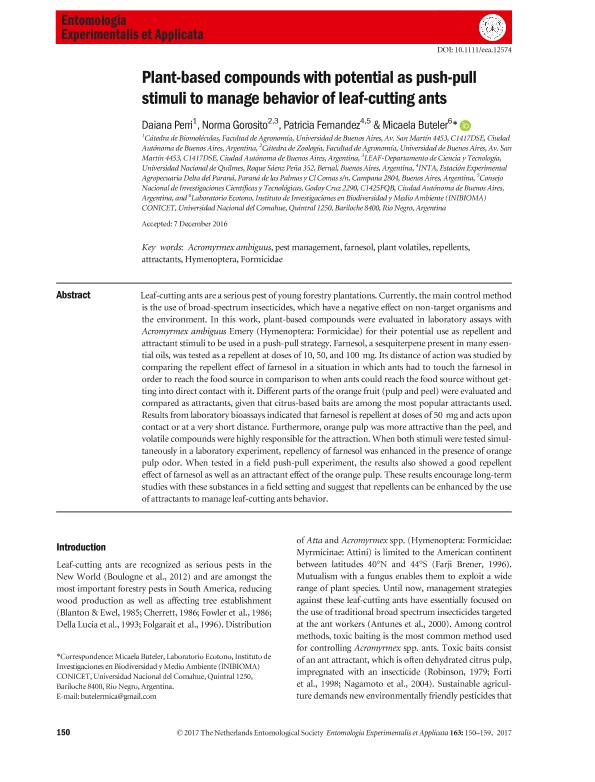Mostrar el registro sencillo del ítem
dc.contributor.author
Perri, Daiana Vanesa

dc.contributor.author
Gorosito, Norma Beatriz

dc.contributor.author
Fernandez, Patricia Carina

dc.contributor.author
Buteler, Micaela

dc.date.available
2019-03-26T20:27:16Z
dc.date.issued
2017-05
dc.identifier.citation
Perri, Daiana Vanesa; Gorosito, Norma Beatriz; Fernandez, Patricia Carina; Buteler, Micaela; Plant-based compounds with potential as push-pull stimuli to manage behavior of leaf-cutting ants; Wiley Blackwell Publishing, Inc; Entomologia Experimentalis et Applicata; 163; 2; 5-2017; 150-159
dc.identifier.issn
0013-8703
dc.identifier.uri
http://hdl.handle.net/11336/72583
dc.description.abstract
Leaf-cutting ants are a serious pest of young forestry plantations. Currently, the main control method is the use of broad-spectrum insecticides, which have a negative effect on non-target organisms and the environment. In this work, plant-based compounds were evaluated in laboratory assays with Acromyrmex ambiguus Emery (Hymenoptera: Formicidae) for their potential use as repellent and attractant stimuli to be used in a push-pull strategy. Farnesol, a sesquiterpene present in many essential oils, was tested as a repellent at doses of 10, 50, and 100 mg. Its distance of action was studied by comparing the repellent effect of farnesol in a situation in which ants had to touch the farnesol in order to reach the food source in comparison to when ants could reach the food source without getting into direct contact with it. Different parts of the orange fruit (pulp and peel) were evaluated and compared as attractants, given that citrus-based baits are among the most popular attractants used. Results from laboratory bioassays indicated that farnesol is repellent at doses of 50 mg and acts upon contact or at a very short distance. Furthermore, orange pulp was more attractive than the peel, and volatile compounds were highly responsible for the attraction. When both stimuli were tested simultaneously in a laboratory experiment, repellency of farnesol was enhanced in the presence of orange pulp odor. When tested in a field push-pull experiment, the results also showed a good repellent effect of farnesol as well as an attractant effect of the orange pulp. These results encourage long-term studies with these substances in a field setting and suggest that repellents can be enhanced by the use of attractants to manage leaf-cutting ants behavior.
dc.format
application/pdf
dc.language.iso
eng
dc.publisher
Wiley Blackwell Publishing, Inc

dc.rights
info:eu-repo/semantics/openAccess
dc.rights.uri
https://creativecommons.org/licenses/by-nc-sa/2.5/ar/
dc.subject
Acromyrmex Ambiguus
dc.subject
Attractants
dc.subject
Farnesol
dc.subject
Formicidae
dc.subject
Hymenoptera
dc.subject
Pest Management
dc.subject
Plant Volatiles
dc.subject
Repellents
dc.subject.classification
Otras Ciencias Biológicas

dc.subject.classification
Ciencias Biológicas

dc.subject.classification
CIENCIAS NATURALES Y EXACTAS

dc.title
Plant-based compounds with potential as push-pull stimuli to manage behavior of leaf-cutting ants
dc.type
info:eu-repo/semantics/article
dc.type
info:ar-repo/semantics/artículo
dc.type
info:eu-repo/semantics/publishedVersion
dc.date.updated
2019-03-26T13:52:00Z
dc.journal.volume
163
dc.journal.number
2
dc.journal.pagination
150-159
dc.journal.pais
Reino Unido

dc.journal.ciudad
Londres
dc.description.fil
Fil: Perri, Daiana Vanesa. Consejo Nacional de Investigaciones Científicas y Técnicas; Argentina. Universidad de Buenos Aires. Facultad de Agronomía. Departamento de Biología Aplicada y Alimentos. Cátedra de Química de Biomoléculas; Argentina
dc.description.fil
Fil: Gorosito, Norma Beatriz. Universidad de Buenos Aires. Facultad de Agronomía; Argentina. Universidad Nacional de Quilmes. Departamento de Ciencia y Tecnología. Laboratorio de Entomología Aplicada y Forense; Argentina
dc.description.fil
Fil: Fernandez, Patricia Carina. Consejo Nacional de Investigaciones Científicas y Técnicas; Argentina. Instituto Nacional de Tecnología Agropecuaria. Centro Regional Buenos Aires Norte. Estación Experimental Agropecuaria Delta del Paraná; Argentina
dc.description.fil
Fil: Buteler, Micaela. Consejo Nacional de Investigaciones Científicas y Técnicas. Centro Científico Tecnológico Conicet - Patagonia Norte. Instituto de Investigaciones en Biodiversidad y Medioambiente. Universidad Nacional del Comahue. Centro Regional Universidad Bariloche. Instituto de Investigaciones en Biodiversidad y Medioambiente; Argentina. Universidad Nacional del Comahue. Centro Regional Universitario Bariloche. Laboratorio de Ecotono; Argentina
dc.journal.title
Entomologia Experimentalis et Applicata

dc.relation.alternativeid
info:eu-repo/semantics/altIdentifier/doi/http://dx.doi.org/10.1111/eea.12574
dc.relation.alternativeid
info:eu-repo/semantics/altIdentifier/url/https://onlinelibrary.wiley.com/doi/abs/10.1111/eea.12574
Archivos asociados
